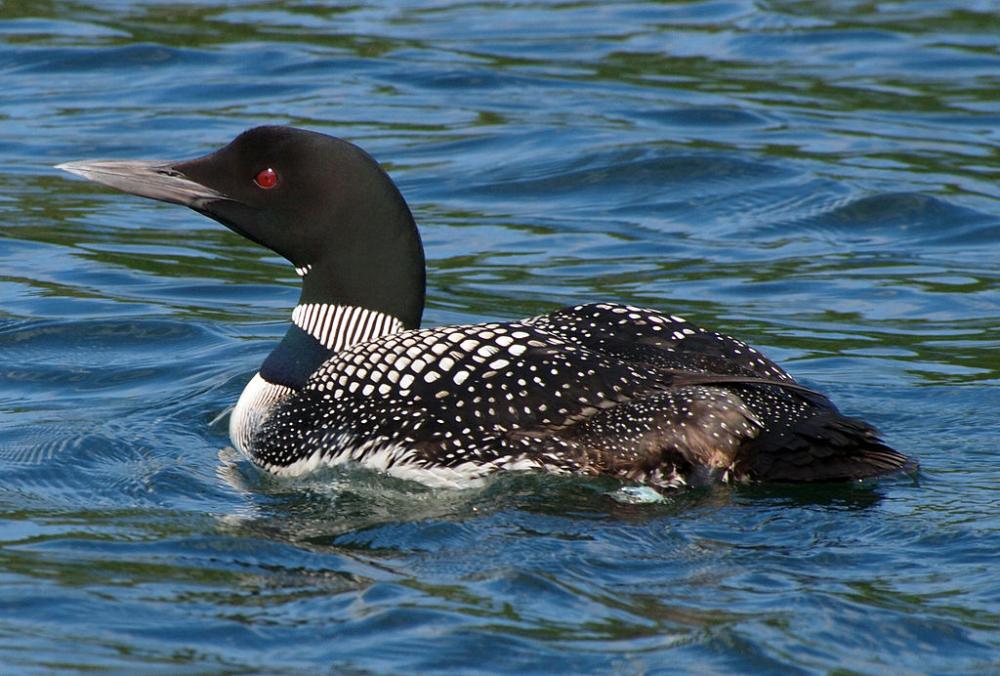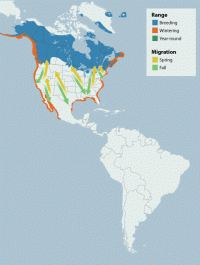Guide to Boreal Birds
This is an in-depth boreal species profile.
What is this?
This species is one of more than 30 birds selected for in-depth profiles. Find out why and see all selected boreal birds »
Overview
Of all the boreal region's birds, perhaps none is as familiar and cherished, embedded in both traditional and popular cultures, and emblematic of the myriad threats to its environment as the Common Loon. It features prominently in many Native American myths and legends and is the subject of tremendous public conservation concern. Its haunting, territorial call is used by filmmakers the world over (often with no regard for geographic accuracy) to evoke a sense of wildness. If any species has galvanized enough interest to save it, it is the Common Loon. It is the official bird of Ontario and the state bird of Minnesota.
The naturalist John Muir, who knew the Common Loon during his early years in Wisconsin, described its call as "one of the wildest and most striking of all the wilderness sounds, a strange, sad, mournful, unearthly cry, half laughing, half wailing." Expert divers, loons have eyes that can focus both in air and under water and nearly solid bones that make them heavier than many other birds; they are able to concentrate oxygen in their leg muscles to sustain them during the strenuous paddling that can take them as far as 200 feet (60 meters) below the surface. Their principal food is fish, but they also eat shellfish, frogs, and aquatic insects. In recent decades, acid rain has sterilized many lakes where these birds formerly bred, and their numbers are declining. A leading cause of loon mortality is lead poisoning caused by the ingestion of lead fishing tackle.
Description
28-36" (71-91 cm). A large, heavy-bodied loon with a thick, pointed, usually black or dark gray bill held horizontally. In breeding plumage, head and neck black with white bands on neck; back black with white spots. In winter, crown, hindneck, and upperparts dark grayish; throat and underparts white.
Voice
Best-known call a loud, wailing laugh, also a mournful yodeled oo-AH-ho with middle note higher, and a loud ringing kee-a-ree, kee-a-ree with middle note lower. Often calls at night and sometimes on migration.
Nesting
2 olive-brown or greenish, lightly spotted eggs in a bulky mass of vegetation near water's edge, usually on an island.
Habitat
Unlike other North American loons, which breed on taiga and tundra ponds, the Common Loon nests on clear lakes with rocky shorelines, deep bays, numerous islands, and floating bogs in forested landscapes across the boreal and Arctic regions. On migration, it uses rivers, large lakes, reservoirs, and coastal regions as staging areas, provided they offer sufficient food; loons concentrate in ice-free inlets and outlets during spring migration. The winter habitat is primarily coastal marine, especially sheltered, relatively clear, food-rich waters such as bays, inlets, channels, and shoals. A few individuals winter inland on fresh water if it remains ice-free.
Range/Migration
Migration routes of this species are poorly known. It presumably chooses a more-or-less direct route that offers adequate staging areas between the breeding and wintering sites. Fall migration occurs between September and December, spring migration from March to June. Birds nesting relatively close to the coast probably take a coastal migration route, while inland nesters necessarily travel some distance overland. The winter range covers nearly the entire North American coastline, from the Aleutian Islands to central Mexico on the Pacific, from Newfoundland to central Florida on the Atlantic, and from central Florida to Tamaulipas on the Gulf of Mexico.
Breeding
The Common Loon breeds throughout subarctic Alaska and Canada and the northern tier of lower 48 states with the exception of the drier plains region; there is an isolated population in the Yellowstone area. Within the Common Loon's specialized breeding habitat, it further requires a sheltered shoreline nest site with an unobstructed view, preferably on an island or floating bog and close to a sheltered, food-rich area of open water that serves as a "nursery pool" for the chicks. The numerous lakes of the boreal region provide excellent breeding and nesting habitat. The shoreline at the nest site must be deep enough to allow underwater approach and egress by the adults to avoid revealing the nest location to predators. Sometimes the tops of muskrat and beaver lodges are used. Pairs form anew every year; the courtship display is simple and quiet, involving head turning and short dives. The adults cooperate in building the nest by collecting vegetation from the vicinity, throwing it into a pile on the shore, and forming it by contouring it around their bodies while sitting. Successful nests often are reused in subsequent years. Two eggs are laid and are incubated by both parents for about four weeks; they defend the nest ferociously against mammalian predators, chasing and, if possible, spearing them with their bills. The young are semi-precocial, meaning that they are downy, sighted, and relatively mobile at hatching but cannot feed themselves. Within a day they accompany their parents to the nursery pool for feeding. They may return to the nest for brooding, but in good weather they climb from the water onto the parents' backs and nestle into the feathers. Frequent periods out of the water are essential for the chicks to thermoregulate because they lose considerable heat through their feet. They may be fed by one parent while riding on the other. They also seek refuge from danger on their parents; if necessary, parents will make short dives while holding the chicks under their wings. By eight weeks of age the young are catching about half their food and several weeks later are feeding themselves completely.
Diet/Feeding Behavior
Young loon chicks are fed aquatic plants, invertebrates, and small fish. As they mature, fish become the primary food, although vegetation and invertebrates are eaten opportunistically, especially when fish are scarce or the water too turbid to find them. Tapered, soft-scaled fish no heavier than 70 grams (2.5 oz) are preferred but fish up to 300 grams (10.6 oz) have been reported eaten. Loons typically forage by swimming with their eyes submerged in search of fish; water clarity is thus an important element in habitat selection. When prey is spotted, they dive and pursue it using the feet for propulsion and the tail for steering. Once the prey is brought to the surface, grasped between the mandibles, it is manipulated and swallowed headfirst; rearward-pointing projections on the palate and tongue prevent the prey from wriggling free. In murkier water loons probe around floating objects and on the bottom for sluggish or immobile prey.
References
Alexander, L.L. 1991. Pattern of mortality among Common Loons wintering in the northeastern Gulf of Mexico. Fla. Field Nat. 19:73-79.
Alvo, R., D.J.T. Hussell, and M. Berrill. 1988. The breeding success of Common Loons (Gavia immer) in relation to alkalinity and other lake characteristics in Ontario. Can. J. Zool. 66:746-752.
Barklow, W.E. 1979. Graded frequency variations of the tremolo call of the Common Loon (Gavia immer). Condor 81:53-64.
Klein, T. 1985. Loon magic. Paper Birch Press, Ashland, WI.
McIntyre, J.W. 1978. Wintering behavior of Common Loons. Auk 95:396-403.
McIntyre, J.W. 1986. Common Loon. Pp. 679-695 in R.L. Di Silvestro (ed.), Audubon Wildlife Report 1986, National Audubon Soc., NY.
McIntyre, J.W., and J.F. Barr. 1997. Common Loon (Gavia immer). In The Birds of North America, No. 313 (A. Poole and F. Gill, Eds.). Philadelphia: The Academy of Natural Sciences; Washington, D.C.: The American Ornithologists' Union.
National Audubon Society. 2002. The Christmas Bird Count Historical Results [Online]. http://www.audubon.org/bird/cbc.
Rummel, L., and C. Goetzinger. 1978. Aggressive display in the Common Loon. Auk 95:183-196.
Sauer, J. R., J. E. Hines, and J. Fallon. 2003. The North American Breeding Bird Survey, Results and Analysis 1966-2002, Version 2003.1, USGS Patuxent Wildlife Research Center, Laurel, MD.
Credits
Birding content provided by National Wildlife Federation/eNature, with support from Ducks Unlimited/The Pew Charitable Trusts.





